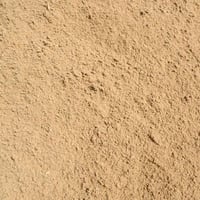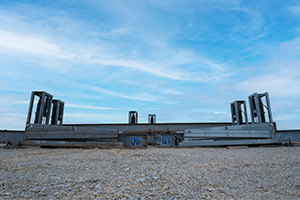Building Tips | Site Preparation
Pole Barn Site Prep: How Much Gravel Do You Need?
Meet FBi's Marketing Content Creator, Julie. With a design degree from Purdue, she develops our brand, captures stunning building photos, and crafts informative brochures.
Disclaimer: Before we dive deep into the gravel recommendations for your pole barn site prep, we want to clarify that this article is specifically written for those who wish to use gravel for their site pad.
There are many great benefits to incorporating gravel into your post-frame building site, but it’s not required. Gravel is just nice to have; you can still have a great post-frame building if you choose not to incorporate gravel.
Now that we got that out of the way let’s get into the specific gravel details that will set your pole barn (and crew) up for success!
We want to give you helpful information, so the recommendations in this article are from great resources within the FBi Buildings family. We talked to Paul Virkler, a senior estimator, Tyler Musk, a Capital Improvement Manager, and Josh DePew, a Project Sales Consultant.
This article will review the following:
- Five reasons to include gravel in your building site prep
- How much gravel is needed for each area
- Common gravel questions and answers
We highly recommend downloading our free site prep brochure if you’re looking for a great resource on building site prep.
1. Five Reasons to Include Gravel in Your Pole Barn Site Prep
If you’re reading this article, there’s a good chance you’ve already decided on including gravel for your site. But if you’re on the fence and want to know the benefits of gravel, here’s a helpful list.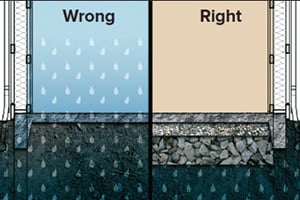
-
Gravel compacts your building pad and provides excellent drainage before and during construction.
-
A gravel driveway makes it easier to deliver materials and equipment to the site.
-
Gravel perimeter helps equipment maneuver around the site without creating ruts in the ground.
-
The gravel staging area makes it easier for crews to unload and procure materials while keeping them clean from debris, mud, and water.
- Not only does gravel make it “easier” for the crew and equipment, but by keeping the large equipment out of the mud, there is a better chance your construction project will be completed on time.
2. How Much Gravel is Needed for Each Area
In the list above, we mentioned including gravel on the building pad, perimeter, driveway, and staging area. So let’s review each one and how much gravel you’ll need for each area:
Building Pad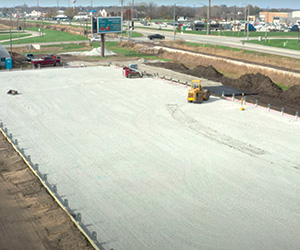
An 8” layer of gravel is ideal for your building footprint. However, we recommend crowning the gravel so it’s a little higher in the middle, allowing water to drain away from your building.
The project may require longer columns if the edges are higher than 8” above grade, so keeping it at 8” thick is best.
Building Perimeter
This is a project-specific answer, but we will give you some guidelines here.
Typically we recommend having the building pad extend a minimum of 10’ beyond the walls of the building. However, it would be ideal for larger post-frame buildings to have a 20’ perimeter, and smaller residential buildings would be fine with a 4’ perimeter.
But no matter the building size, we recommend it to be 8” thick, just like the building pad. And allow the gravel to taper off the edges for extra support and avoid erosion.
Driveway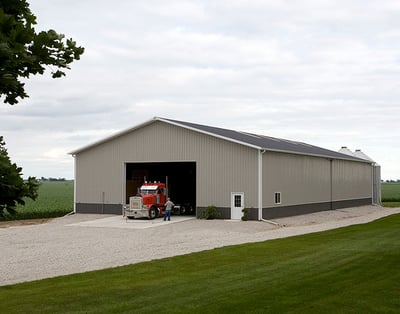
If the driveway is straight, we usually recommend a minimum of 10’ - 12’ (prefer 15’ or as wide as possible to limit vehicle congestion), as concrete trucks and semis are around 8’ wide.
If there are curves or bends in the driveway, we recommend at least 16’ minimum width to avoid tires causing ruts on either side of the driveway as they attempt to navigate the corner.
Also, consider the turning radius of a semi turning in off of the road. For example, the typical delivery semi will need about a 25’ turning radius to access the driveway off the road.
Again depending on the site layout, if the semi cannot back out of the driveway onto the road, they will also need a 53’ turning radius somewhere on the site to do a 180° turn-around and pull out.
Staging Area
The staging area is a very project-specific need, and there isn’t a right or wrong answer to how large it should be. We recommend talking to your Project Sales Consultant about where the staging area should be located and how big it needs to be.
For more information on building site prep, check out our podcast episode, where we talk to a few project managers on Tips for a Successful Pole Barn Project.
3. Common Gravel Questions and Answers
QUESTION #1: What type of gravel does FBi Buildings recommend for building site prep?
ANSWER: We would recommend starting with a layer of #2 gravel as a base layer (typically 6” thick), then covering it with a layer of #53 stone and lime. The #53 gravel will “lock in” the #2 gravel, and create an excellent surface to drive on, and operate the equipment.
Either the #2 or #53 gravel size installed on its own will not support the load and will just sink into the mud when driven on.
GRAVEL #2 (left) GRAVEL #53 (right)
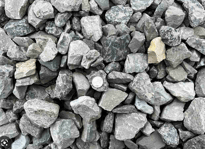
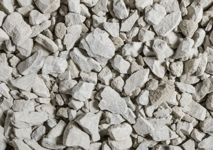
QUESTION #2: How many tons of gravel do I need to order?
ANSWER: Here’s the equation you need to know: Length in feet x Width in feet x Depth in feet (inches divided by 12). Take the total and divide by 21.6 (the number of cubic feet in a ton). The final figure will be the estimated amount of tons required.
Here is a real-life example of determining how much gravel you need for the building pad and perimeter. The building size is 80’ x 120’, with a 10’ perimeter, so we will do calculations for 100’ x 140’.
Gravel #2 will be a 6” Thick Base
| STEP 1 | 6 / 12 = .5 |
| STEP 2 | 100 x 140 x .5 = 7000 |
| STEP 3 | 7000 / 21.6 = 324.07 tons of #2 gravel |
Round up to 325 to allow for gravel to taper
Gravel #53 will be a 2” Thick Topper
| STEP 1 | 2 / 12 = .167 |
| STEP 2 | 100 x 140 x .167 = 2338 |
| STEP 3 | 2338 / 21.6 = 108.2 tons of #53 gravel |
And if you don’t feel like doing the math, here’s a great online gravel calculator that will help!
Remember that the above calculations are for the building pad and perimeter only. You must do separate estimates for the driveway and staging area, then add them to the building pad and perimeter totals.
QUESTION #3: What are the other options if I don't want to use gravel?
ANSWER: That is a great question, and we are so glad you asked! There are several different types of granular fill and typical use for each one. A few are listed below, but check out page 14 of our Site Prep Ebook for more options and details.
|
|
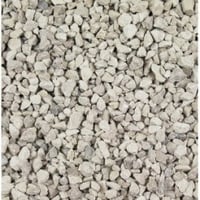
|
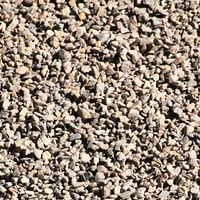
|
||
| Sand Used as a fill in areas containing sandy soils; needs to be top dressed with a compacted stone. |
Crushed Limestone Commonly used as a finished surface in many equine applications. |
Pea Gravel |
QUESTION #4: Do I need extra gravel for the QLYFT Building System?
ANSWER: Nope! The QLYFT Building System doesn’t require any extra gravel.
QUESTION #5: Does my soil affect how much gravel I should get?
ANSWER: Yes! Soil type is a significant factor in how much stone is needed.
Sod & clay soils tend to create mud after some rain and can cause many site challenges for vehicles and equipment without adequate gravel.
Sandy and loose dirt soils are less susceptible to weather and do not require as much rock to operate on. If you have sandy and loose dirt type of soil, then we recommend talking it over with a stone specialist.
Are You Ready to Start your Building Site Prep?
Your building pad can make or break your project. Building a pad right the first time can save costs and overall time and ease construction. If that’s the only area you decide to gravel, you’re still setting your project up for great success.
Remember that laying gravel is just one part of the building site prep process. Check out this free brochure to learn all the tips and recommendations for a proper site prep plan.


